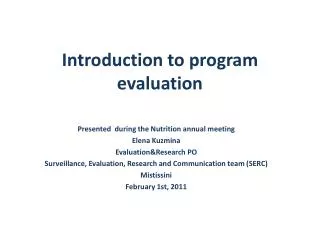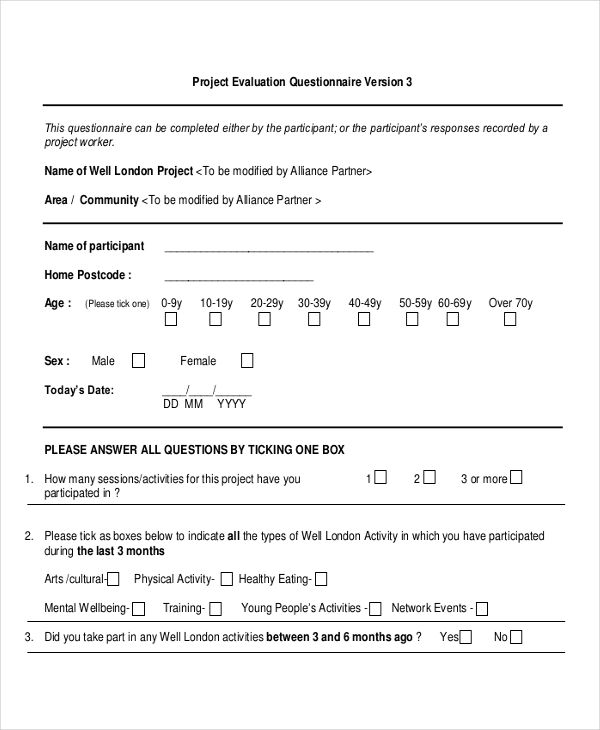Imagine pouring countless hours into developing a new program, brimming with potential to improve lives. You’ve carefully crafted the design, assembled a dedicated team, and secured funding. Yet, after months of implementation, a nagging question lingers: Is this program truly making a difference? This is where program evaluation steps in. It’s the critical process of systematically gathering evidence to determine the effectiveness and impact of programs.

Image: www.slideserve.com
Program evaluation isn’t just about ticking boxes or satisfying grant requirements. It’s about understanding how well a program achieves its goals, identifying areas for improvement, and making data-driven decisions for the future. It’s the bridge between good intentions and tangible results, ensuring that our efforts are truly benefiting those we aim to serve.
Understanding the Power of Evidence
In today’s data-driven world, evidence is paramount. It’s what separates mere assumptions from well-informed conclusions. Program evaluation, by providing evidence-based insights, empowers organizations and communities to make better decisions and maximize their impact.
Think of it as a roadmap. Instead of relying on gut feelings or anecdotal observations, program evaluation provides concrete data points to guide us toward optimal outcomes. It allows us to understand what works, what doesn’t, and why.
What is Program Evaluation?
Program evaluation is a systematic process of collecting and analyzing information about the effectiveness and impact of a program. It involves setting clear objectives, collecting relevant data, and interpreting that data to draw meaningful conclusions.
At its core, program evaluation seeks to answer important questions about a program. These questions can range from simple ones, such as “Is the program reaching its target audience?” to more complex ones, like “Is the program actually leading to a positive change in the lives of participants?”
Why is Program Evaluation Important?
Program evaluation is essential for several reasons:
- Accountability: It provides evidence to demonstrate the program’s value and accountability to funders, stakeholders, and the public.
- Improved Effectiveness: Evaluation findings can be used to identify strengths and weaknesses, enabling program refinement and improvement.
- Resource Allocation: Data-driven evidence can guide decisions about resource allocation, ensuring that funding is directed towards programs that are truly effective.
- Learning and Growth: Evaluation fosters a culture of learning and continuous improvement, enabling organizations to adapt to changing needs and contexts.
- Evidence-Based Policy: Program evaluation provides valuable insights that can inform policy decisions and shape future interventions.

Image: survey-faqs.com
Types of Program Evaluation
1. Formative Evaluation:
Formative evaluation focuses on improving program design and implementation during its initial stages. It helps identify potential issues and areas for improvement before they become major problems.
2. Summative Evaluation:
Summative evaluation assesses the overall effectiveness of a program after it has been fully implemented. It typically involves measuring outcomes against predefined objectives to draw conclusions about whether the program achieved its intended impact.
3. Process Evaluation:
Process evaluation examines how a program is operating in practice. It looks at factors such as program delivery, participant engagement, and resource utilization to understand the program’s implementation process.
The Evolution of Program Evaluation
Historically, program evaluation relied primarily on quantitative methods, such as surveys and data analysis. However, in recent years, there has been a growing recognition of the importance of qualitative methods, such as interviews, focus groups, and document reviews, to provide a richer understanding of the nuances of program impact.
The emergence of mixed-methods approaches, combining both quantitative and qualitative methods, has led to a more comprehensive and nuanced approach to program evaluation.
Furthermore, technological advancements have revolutionized how we conduct program evaluation. Data collection platforms, online survey tools, and data analysis software have simplified the process and enhanced the efficiency of data gathering and analysis.
Trends and Developments
The field of program evaluation is constantly evolving. Here are some noteworthy trends and developments:
- Big Data Analytics: With the increasing availability of large datasets, program evaluators are utilizing powerful analytic techniques to extract meaningful insights from complex data.
- Impact Evaluation: There is a growing emphasis on conducting impact evaluations to understand the long-term effects of programs, particularly in areas such as development and social change.
- Rigorous Research Designs: As the field matures, program evaluation is increasingly incorporating rigorous research designs, such as randomized controlled trials, to strengthen the causal inferences drawn from evaluation findings.
- Equity and Inclusion: Program evaluators are paying greater attention to equity and inclusion considerations, ensuring that evaluation methods and findings are sensitive to diverse perspectives and experiences.
Expert Tips
If you’re embarking on a program evaluation, consider these expert tips:
- Start Clear: Define your program objectives and key questions you want to answer before you start collecting data.
- Choose the Right Approach: Select evaluation methods that are appropriate for your program and research questions.
- Engage Stakeholders: Involve program staff, stakeholders, and beneficiaries in the evaluation process to ensure buy-in and relevance.
- Communicate Effectively: Present evaluation findings in a clear, concise, and accessible manner to ensure that results are understood and acted upon.
- Embrace Continuous Learning: View program evaluation as an ongoing process of improvement, engaging in reflective practice and incorporating findings into program design and implementation.
FAQ
Q: Who conducts program evaluation?
A: Program evaluation can be conducted by internal staff within an organization, external consultants specializing in evaluation, or a combination of both. The choice typically depends on the program’s scope, the organizational resources, and the nature of the evaluation.
Q: How do I choose the right evaluation methods?
A: The choice of evaluation methods should align with the program’s objectives, the research questions being addressed, and the available resources. It may involve a mix of methods, such as surveys, interviews, observations, and document analysis.
Q: What does a good program evaluation report look like?
A: A good evaluation report should clearly describe the program, the evaluation methods used, the key findings, and the implications for future program development and implementation. It should be written in a clear and accessible style, with supporting evidence and data visualizations.
Program Evaluation: An Introduction To An Evidence-Based Approach
https://youtube.com/watch?v=uHL-l_Iz_sA
Conclusion
Program evaluation is a critical tool for ensuring that our programs are effective and impactful. By adopting an evidence-based approach, we can make informed decisions, optimize program design, and ultimately achieve better outcomes for the communities we serve. Remember, program evaluation is not just about measuring success, it’s about learning and growing to make a real difference in the world.
Are you interested in exploring program evaluation further? Let us know your thoughts and questions in the comments below.






